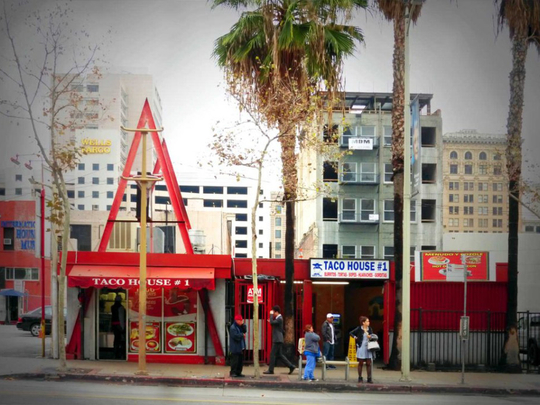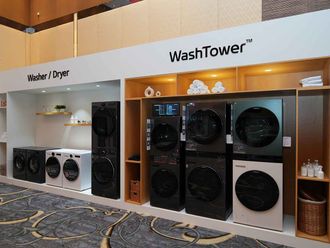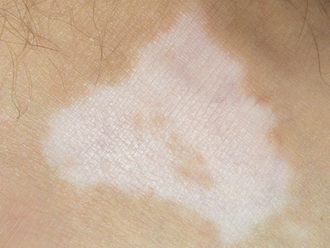
On 8th street in the heart of downtown Los Angeles, a single stair leads to a raised, red and white tile platform. This trash-strewn urban ruin is tucked into the corner of a large parking lot within sight of the neon marquees of the Broadway theatre district. It is what remains of Taco House, one of LA’s iconic hamburger stands, which are quickly being erased from this rapidly transforming city.
Los Angeles is, of course, inextricably associated with the automobile, and it was here that many suburban building types — from modernist homes to fast-food restaurants — were pioneered. But it is changing: five transit lines are being built, and cranes loom over the city’s boulevards. The epicentre of this transition is the once moribund downtown, where a denser and wealthier city is displacing, among other things, one of its old, car-oriented icons.
The hamburger stand is part of southern California’s rich tradition of roadside architecture. These buildings are typically 100 square-foot boxes, with an outdoor window to order and pick up food. Next to the structures are rudimentary dining areas, often consisting of no more than a plastic tarp and a few fold-up chairs and tables. To compensate for their diminutive size, the stands sometimes have large signs and, in more elaborate cases, are decorated to resemble everything from a log cabin to a traditional Korean house.
LA’s hamburger stands have held the fascination of visiting critics since the 1970s. Architects Denise Scott Brown and Robert Venturi famously coined the terms “ducks” and “decorated sheds” to describe buildings such as these, that use signage or elaborate decoration to signify their purpose.
Reyner Banham, in his seminal book Los Angeles: The Architecture of Four Ecologies, wrote rapturously about hamburgers as being “a work of visual art” and a “fantasia on functional themes”, comparable to the buildings in which they are sold.
The rise of the hamburger stand coincided with the decline of downtown Los Angeles. In the early part of the 20th century, it was the dominant centre of southern California, accounting for 90 per cent of all retail sales. The hulking beaux arts buildings that line streets such as Spring and Broadway are a testament to downtown’s former commercial might.
However, as early as the 1920s, the car began to decentralise the city, and the need for parking subsumed downtown. Hundreds of buildings were levelled to accommodate parking lots, such as the Armory Building, which once occupied the site of Taco House. This imposing, Romanesque revival edifice, which for a time housed the city’s main post office, was levelled in 1938 and replaced by 800 sq ft of asphalt and a tiny stand. There are approximately 20 hamburger stands left in downtown Los Angeles.
They began to appear in the early 1930s, rapidly proliferated throughout the 1940s and 1950s, and the last was built in 1964. Only a fraction still serve food; others have been converted or stand vacant.
As white collar industries moved out of downtown in the mid-century, they were replaced by blue collar wholesalers. Responding to the new demographic brought in by these industries, kebabs, bibimbab and tortas joined hamburgers on the menus of many stands.
Ye Old Taco House has occupied the corner of a large parking lot at 4th and Hill Street since 1962. Like many of the stands, it is an immigrant-owned enterprise run by Maria Morales and her son Josh. On a slow Tuesday night, Maria helps in the kitchen as an older relative sits in the corner, watching TV. The Morales have operated the restaurant for 11 years, while the neighbourhood has transformed around them.
“Before it was only Hispanic people, now it’s everything: American people, Chinese people,” Maria explains. As we speak, two security guards walk in, ordering in Spanish, followed by a tattooed rocker, most likely in the area for one of the new trendy bars that have opened up nearby.
Downtown is the centre of one of the most diverse cities on the planet, and the eclectic menus of many of the stands cater to an array of palates. The menu at Kiku Teriyaki includes all the standard teriyaki dishes as well as a large assortment of Korean ones, ranging from spicy squid and kimchi stew to mackerel pike with kimchi. “All the restaurants on this street are owned by Koreans but I am the only one serving Korean food. They all eat here,” says its owner, Lee. “Non-Koreans usually order teriyaki, but Mexicans and Armenians order Korean dishes because they like spicy food.”
Further south, Maya Heidary is preparing her stand for its grand opening. Built in 1931, Maya’s (as it is now known) is the oldest hamburger stand in downtown LA, and its log cabin facade and frying pan clock have changed little over the decades. Heidary is the fourth owner in the last year, and is having difficulty figuring out how to position her new restaurant in the changing neighbourhood.
“There are all kinds of customers here: high class, middle class,” she says. “It makes it very hard to plan my menu, because if the price is too low you won’t get the high class people, and if it’s too high you won’t get the middle class people. That is why many of the stands around here serve all kinds of food.”
Her stand has traditionally served Mexican food, and she plans to keep burritos and tacos on the menu while gradually expanding into hamburgers, pizzas and wraps.
With downtown LA now boasting a residential population that has grown to over 50,000, many stands have benefited. “It’s busy all the time now: lunchtime, in the evenings,” says Maria Morales.
But these affluent new residents are not the traditional patrons of hamburger stands, and many have had to adapt. The Husky Boy stand on Broadway and 8th served office workers for decades with an “only in LA” menu of burritos, tacos and pastrami (a legacy of the Jewish and Mexican residents of Boyle Heights, east of downtown). In 2012, its mishmash facade was cleaned up and painted over with a colourful mural when it was taken over by Two Boots Pizza, a New York franchise with unorthodox pizzas with ingredients like creole chicken and jalape-o pesto.
Phil Hartman, the owner of Two Boots, was urged to come downtown by some adjacent businesses and was astonished by the buildings in the area. The diminutive stand is sandwiched between the Platt Building, a gothic revival office tower, and the elaborately ornamented Wurlitzer Building.
“I didn’t even know Los Angeles had a centre, I think a lot of people think that,” admits Hartman, a New Yorker. With its googie architectural detailing, vivid signage and outdoor seating area, Two Boots is one of the better preserved stands in downtown. A self-described preservationist at heart, Hartman says the structure was in such poor condition that it had to be “rebuilt from scratch”. An “early adopter” of downtown, Two Boots has since been joined on the surrounding blocks by the uber-trendy Ace Hotel as well as high fashion outlets from Sweden and France.
But this rising affluence threatens the stands’ much-loved status as bastions of unpretentious, affordable food. Kim can point to each business on his block and list their rents: $7,000, $6,500, $3,000 a month. At these levels, it is nearly impossible for many of the stands to stay in business in their current form. While an entire burrito goes for $5 at many stands, at Two Boots a single slice of pizza costs $4.09.
The hipsterfication of LA’s hamburger stands may, however, prove the final chapter in the saga of these half-century-old structures. A construction boom is transforming the landscape, with parking lots becoming new buildings on what seems like monthly basis. The Anzutei ramen stand on Spring Street will soon be replaced by a 28-storey luxury hotel. A 33-storey high-rise is planned for the site of Ye Olde Taco House, and those red and white tile remnants on 8th will soon be cleared to make way for a 24-storey residential tower.
Los Angeles’s transition to being denser and less car dependent is unquestionably a good thing, resulting in a more liveable and sustainable city. However, the loss of these tiny stands stokes a broader anxiety about the changes brought about by this process. These idiosyncratic, populist buildings represent the entrepreneurial, immigrant city that Los Angeles has become since the rise of the automobile. Their destruction in favour of luxury behemoths is a symbol of the city gaining wealth while losing some of its character.
Despite this tension, the re-urbanisation of Los Angeles’ core is, in a sense, the city going back to the future. If we look at photographs of downtown in the 1920s, it looks like New York or London: dense and bustling with streets packed with pedestrians, cars and trams.
So perhaps the sprawling, car-obsessed Los Angeles of the post-war era was simply an aberration. In the future, this period of car worship, which so defines the city in the popular imagination, might be seen as a stepping stone to a more urban and urbane place — albeit one with less pastrami cheeseburgers.
–Guardian News & Media Ltd












